A new study has revealed children who eat too much oats, bananas and yogurt are at risk of developing type 1 diabetes. The study also found that wheat emerged as a risk factor for the autoimmune form of diabetes.
The researchers found that consuming strawberries and blueberries lowers the risk of getting type 1 diabetes. Similarly, vegetables such as broccoli, cauliflower and cabbage have a protective effect against the autoimmune form of diabetes.
Suvi Virtanen and colleagues at the Finnish Institute for Health and Welfare analysed the diet of 5,674 Finnish children who were genetically susceptible to the disease, following them from birth to the age of six. The researchers revealed that some fruits contain traces of pesticides may explain why some of them heighten, but others cut, the risk of type 1 diabetes.
During the study, the scientists found that 94 of the children had developed type 1 diabetes by that age and another 206 had developed islet autoimmunity, which meant they were at much higher risk of getting it.
“…many of the foods that we found to be associated with increased risk of type 1 diabetes and the disease process are considered part of a healthy diet,” Virtanen said as quoted by The Guardian.
“Berries are particularly rich in polyphenols, plant compounds which may dampen the inflammation that is associated with the development of type 1 diabetes. On the other hand, fruits may contain harmful substances that don’t occur in berries. For example, berries can be free of pesticides that are found on other fruits,” said Virtanen.
She is presenting her findings at the annual meeting of the European Association for the Study of Diabetes in Madrid, as per The Guardian.
She added: “It is important to find out which factors in these foods are responsible for these associations. If berries are found to contain a particular protective factor, for instance, either that substance or berries themselves could be used to prevent T1D.”
She also maintained that it would be premature to issue any dietary recommendations for what babies and infants should eat, based on the findings.

